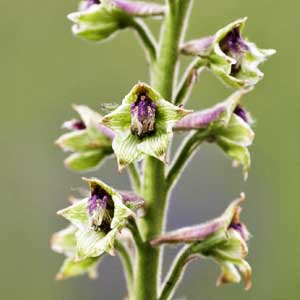Delphinium viridescens
Delphinium bakeri
Wenatchee larkspur
Baker's delphinium, Baker's larkspur
90-150 cm;
base usually green, glabrous.
(45-)60-85(-100) cm;
base reddish, glabrous.
blade cuneate to semicircular, 2-5 × 3-12 cm, nearly glabrous; ultimate lobes 3-21, width 1-8 mm.
blade pentagonal to round, 1-6 × 1.5-8 cm, margins crenate, glabrous; ultimate lobes 3-5, width 2-5 mm (basal), 5-30 mm (cauline), widest at middle or in proximal 1/2.
25-80-flowered, dense;
pedicel 0.5-2 cm, glandular-pubescent;
bracteoles 1-4 mm from flowers, green, lanceolate, 3.5-6 mm, glandular-pubescent.
8-23-flowered, at least 2 times longer than wide;
pedicel 1-6(-9) cm, glandular-puberulent;
bracteoles 4-6 mm from flowers, green to blue, lance-linear, 5-8(-13) mm, glabrous to glandular-puberulent.
sepals yellowish green, nearly glabrous, lateral sepals forward pointing, 7-9 × 3-4 mm, spurs decurved, 30-45° below horizontal, often hooked apically, 8-11 mm;
lower petal blades ± covering stamens, 4-6 mm, clefts 0.5-1.5 mm;
hairs centered, mostly near junction of blade and claw, yellow.
sepals dark bluish purple, nearly glabrous, lateral sepals spreading, 9-11 × 4-5 mm, spur apex decurved, ± horizontal, 9-13 mm;
lower petal blades ± covering stamens, 5-7 mm, clefts 2-3 mm;
hairs sparse, mostly near base of cleft, centered or on inner lobes, white.
8-11 mm, 2.5-3 times longer than wide, puberulent.
18-20 mm, 3.5-4 times longer than wide, glabrous.
± wing-margined;
seed coat cells with surfaces ± roughened.
unwinged;
seed coats smooth.
Delphinium viridescens
Delphinium bakeri
Of conservation concern.
Delphinium viridescens is local in mountains southwest of Wenatchee, Washington.
(Discussion copyrighted by Flora of North America; reprinted with permission.)
Of conservation concern.
Delphinium bakeri is possibly extinct in the wild because of cultivation and sheep grazing in the small area where it grows. It is known from only two localities and has not been collected since 1960. Plants have been grown at Strybing Arboretum, Golden Gate Park, San Francisco. Although their geographic ranges are distinct, D. bakeri is most similar to, and probably closely related to, D. trolliifolium. The former has more rounded incisions on the leaves than the latter, and the pedicel of D. bakeri are consistently glandular. Glandular pedicel appear only occasionally in D. trolliifolium.
(Discussion copyrighted by Flora of North America; reprinted with permission.)


